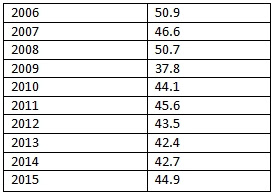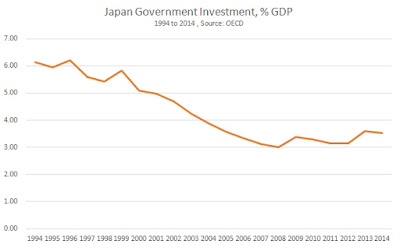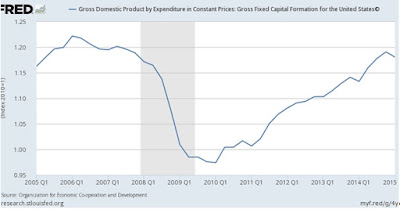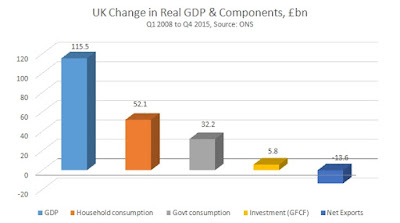Why Osborne fails to cut the deficit- and how John McDonnell can
By Michael Burke
As the UK economy is slowing once more, it is likely that the public sector deficit will begin to rise again as it did in 2012 under the impact of economic stagnation. George Osborne’s claimed target of deficit-reduction will once more recede on the horizon.
The Office for National Statistics (ONS) has recently published the data for public sector finances for the Financial Year ended in April. This shows a deficit of £76 billion, even though George Osborne (in)famously claimed he would eliminate the deficit in the previous year.
An examination of these data shows how the austerity policy has failed in its stated objective of deficit-reduction. More importantly analysis shows how the Labour plan initiated by Jeremy Corbyn and John McDonnell can regenerate the economy and thereby end the crisis in government finances.
Deficits matter
In the first instance it is important to state why public sector finances matter as there are some, even among progressive economists, who seem to believe that large scale deficits are of no consequence, or should even be permanently embraced.
Deficits matter because they are a tax or lien on the public sector by the private financial sector via the bond market. So for example, because of the current crisis government interest payments have remained exceptionally low and are effectively unchanged since before the crisis at just over £30 billion per annum. At some point interest rates should recover to pre-crisis levels. Only if there is a permanent crisis will interest rates remain unaltered. Pre-crisis interest rates combined with the current trebling of the level of Government debt would see interest payments soar. These are funds that could be used for productive investment or in providing government services. Instead, there would be increased payments by governments to the financial sector which is the principal source of the outsized growth of the financial sector (pdf), which is frequently but mistakenly described as ‘financialisation’.
Outside exceptional periods, routinely borrowing via the bond market is justified only if the return to the government is greater than the initial outlay, which can only occur via investment. Under these conditions, the borrowing is used to grow the economy and, far from leading to an outsized financial sector reduces its relative weight in the economy because the productive sectors grow more rapidly led by public investment.
Osborne’s track record
To date the progress in eliminating the deficit has been painfully slow. The Tory-led Coalition came into office in May 2010, almost coinciding with the beginning of the new Financial Year. As most Government spending and revenue is determined by policies and economic trends from the preceding year, the more accurate starting-point to gauge the effect of austerity policies should be the total deficit in 2010/11, which was £137 billion. As noted above, the deficit at the end of FY 2015/16 was £76 billion. Far from eliminating the deficit in 5 years, Osborne has not even halved it.
Yet contrary to the claims of the extreme right, there have been very substantial cuts in public spending. As a proportion of GDP public sector spending has fallen from 43.9% of GDP to 38.2% in 2015/16. In relative terms this is a decline of 12% while the population has increased by 3.55% over the same period. Austerity is real.
Even so, because the economy has grown modestly and there has been inflation, the nominal level of public spending has increased from £681 billion to £716 billion. It is extremely difficult to reduce the deficit by cuts. They have to be on an enormous and devastating scale, like Greece, to achieve even very modest outcomes.
The principal factor which has led to modest deficit reduction in the UK is modest economic growth. While nominal Government outlays have risen by £35 billion to £716 billion, over the same period Government revenues have risen from £577 billion to £682 billion. If the OBR estimates of outlays and receipts are presented in real terms, adjusted for inflation the same trends are evident. Outlays have risen by £11 billion in real terms while receipts have risen by £62 billion. It is growth, not austerity which has produced deficit reduction.
Austerity and the deficit
Under Osborne, and supported by the entire Tory parliamentary party, the minimal reduction in the deficit has only occurred via growing Government receipts, which is a product of economic growth. The reason that progress has been so slow is that growth itself has been too weak.
This weakness of economic activity is a product of austerity policies. Although the cuts to investment are the least visible cuts of all, they are the most damaging to the living standards of the population over the medium-term precisely because investment raises the level of GDP.
The most direct effect of this slow growth is on the Government current account, not on the capital account itself. This is because growth increases all types of tax revenues as more people are in better-paid jobs. In addition Government outlays fall for the same reason as unemployment benefits fall along with social protection payments for the low paid.
The cut in the level of Government investment has produced a ‘saving’ of £16 billion in the most recent Financial Year compared to the peak level during the crisis. However the cumulative effect over 6 years of continuous cuts to investment has been to reduce the capital stock by £50 billion compared to what would have been the case if investment had been maintained at previous levels.
The direct effect of the cuts to investment on the current account includes two factors. First is the lower level of GDP simply by reducing investment, which is £16 billion. But fixed investment constitutes additions to the net capital stock, what used to familiarly be known as the means of production and the cumulative reduction under the Tories has been £50 billion. Secondly, therefore, it is also necessary to calculate the loss in production arising from this reduction in the net capital stock.
One way of estimating this loss of output is by using the Incremental Output Capital Ratio (IOCR). This is the measure of the level of the additional capital stock required to increase output by 1 unit a given year. It is calculated by dividing the capital stock by the level of annual Gross Value Added.
According to the Office for National Statistics (ONS) the total IOCR for the net capital stock is 2.6. This means that to increase output by £1 billion in a single year it is necessary to increase the capital stock by £2.6 billion. Other estimates put the IOCR much higher, but as this is the official estimate, it will be accepted for now in the calculations below.
The reduction in the net capital stock arising from the Government’s cuts to investment amounts to £50 billion over 6 years, as noted above. If the IOCR is 2.6 then this reduction in the net capital stock reduces output in the latest year by £19 billion (50 ÷ 2.6).
Therefore the total reduction in output in the latest year is the sum of the reduction in investment (£16 billion) plus the cutback in output arising from the reduction in investment (£19 Billion). The combined effect of these two in the latest year is to reduce GDP by £35 billion. A ‘saving’ of £16 billion in Government investment has led to a total reduction in output of £35 billion in the same year.
The champions of austerity, including Osborne himself rarely talk about the actual cuts to investment that have been made by successive Tory Governments precisely for the reason that they are almost impossible to justify within any reputable economic framework.
Fiscal impact is on the current account
As we have already noted a reduction in the level of GDP is the main cause of the fiscal deficit, while moderately higher growth has led to a moderate reduction in the deficit. It is the policy of cutting investment which is the primary cause of ongoing economic weakness and consequent inability to eliminate the deficit.
The effect of changes in GDP to changes in Government finances has been analysed previously by the UK Treasury and cited previously by SEB. Public finances and the cycle (UK Treasury Working Paper Number 5) estimates that for every £1 change in economic output, Government finances benefit by £0.75. 50 pence of that improvement arises from increased taxation revenues and 25 pence derives from automatically lower outlays.
This is the ‘automatic stabilisers’ working in reverse; just as Government finances deteriorate in a slowdown they automatically improve in an upturn. It should be noted that the entirety of this improvement is registered in the current account in terms of both day-to-day revenues and outlays.
Returning to the current example a cut of £16 billion in Government investment has led to a reduction in GDP of £35 billion. But this also has a negative impact on the Government current account of approximately £27 billion (35 X 0.75).
So, using official estimates, a cut of £16 billion in investment has led to a deterioration in Government finances of £27 billion, a net deterioration of £11 billion. All of this deterioration is registered in the Government’s current account, which is why it proves so intractable. Any actual deficit reduction is the combined product draconian cuts to public services, higher tax rates and very modest growth.
There are differing estimates of the ICOR for the UK economy, some much higher that the ONS estimate. This would have the statistical effect of limiting both the damage to growth and the negative impact on Government finances as a result, and cannot be dismissed. But in this piece there has been no attempt to include the spillover or ‘induced’ effects of Government investment on private sector investment, which would be an offsetting factor even if the direct damage to the economy and the public finances is overstated using official ICOR estimates. An illustration of these induced effects would be, say, if the public sector were to engage in a major house building programme then this might induce private brick makers or other producers of inputs to increase their investment.
It is easy to set the damaging effects of austerity into reverse. Jeremy Corbyn and John McDonnell have emphasized repeatedly the centrality of investment to their economic programme of regenerating the economy. For this reason, they stress that they will borrow for investment. This is exactly correct. There should be no confused or silly allegations that this is an austerity-lite programme, or similar. As shown above, their planned reduction in the current deficit naturally follows from a significant increase in public sector investment.





















Recent Comments